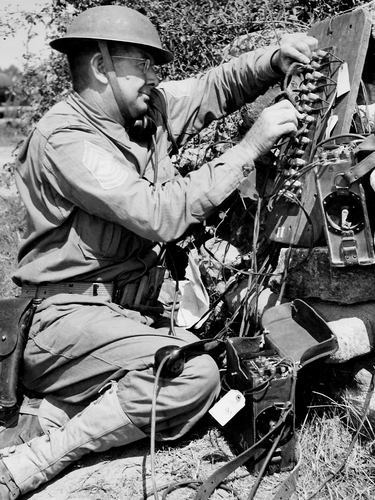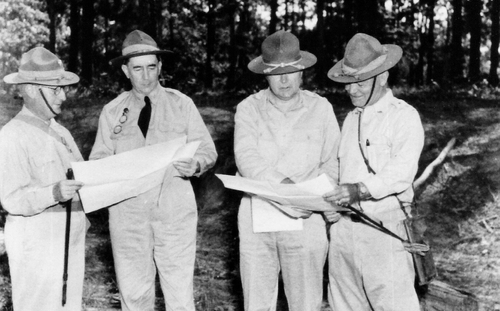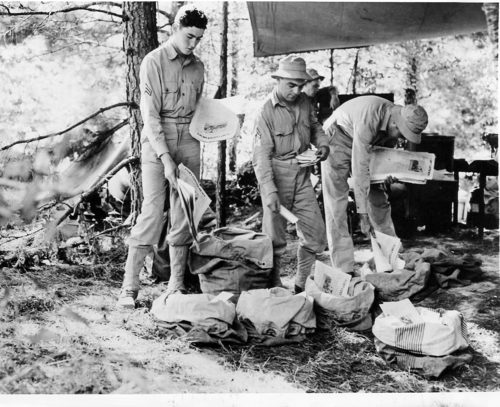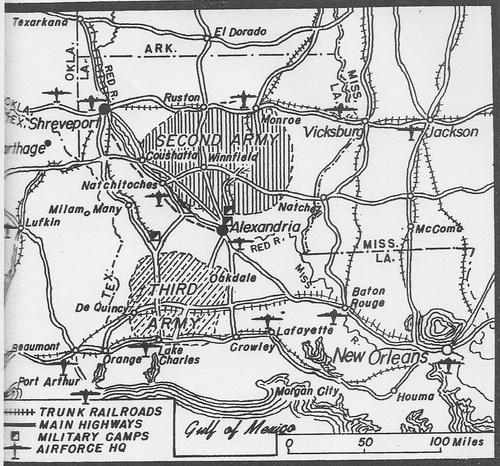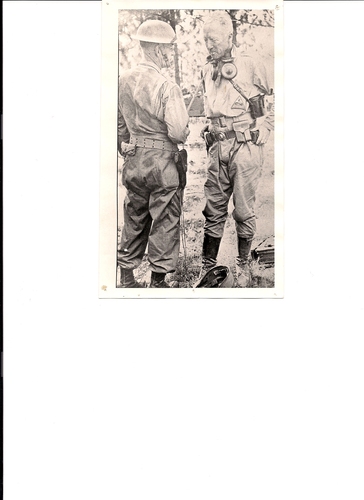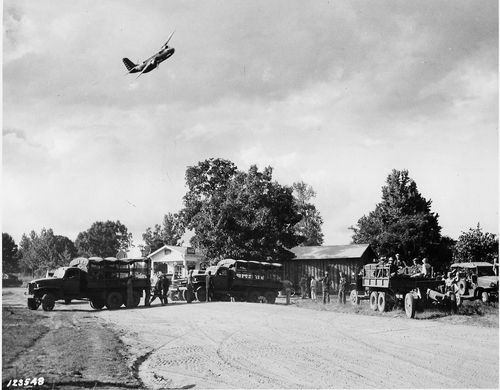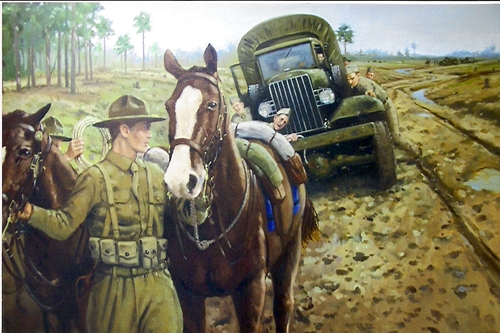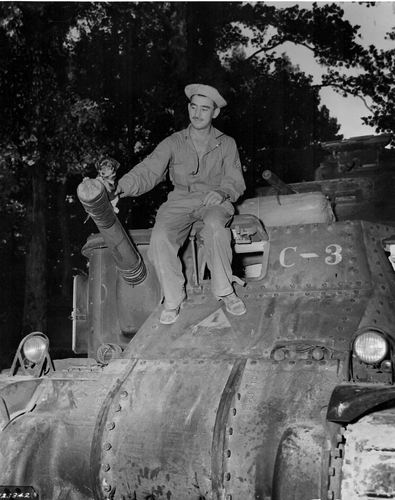.JPG)
Remembering the Louisiana Maneuvers of 1941
By Rickey Robertson
One of the greatest military events in history took place 71 years ago this month in Louisiana and East Texas. This great event was known as the Great Louisiana Maneuvers of 1941. These maneuvers actually prepared the United States Army for World War II. Since World War I, there had been no actual field maneuvers held by the Army. The army had a strength of only 190,000 men and 45,000 of these were stationed overseas in places such as the Philippines. General George C. Marshall, the new army Chief of Staff, needed to build a bigger, better equipped army, for he could see the war clouds rising in Europe. In 1939 he got with President Franklin D. Roosevelt and came up with a plan. On September 8, 1939 President Roosevelt initiated a "Protective Mobilization Plan". Many young Americans did not know it, but the draft was on its way! General Marshall wanted any mistakes made in training to be made in Louisiana, not on the battlefields possibly in Europe.
General Marshall appointed Lt. General Leslie McNair as director of all army training. By June of 1941 General McNair had nearly 1 million men ready to train. But where to train all these men ? In 1940 many small units began small scale maneuvers throughout the United States, but principally in the South. In Louisiana from June 1940 until the 1941 Maneuvers began in August and September 1941, small units of different branches of the Regular Army began training in Louisiana. And many young officers began learning tactics that would make them famous in World War II. Great shortages of equipment of all types were found. The new M-1 rifle was in short supply, blank ammunition was in short supply, field equipment of all types was in short supply or were old World War I era, and armored vehicles for the new Armored Force were limited. The 1940 Maneuvers brought out these shortages and by September 1941, the US Army was ready to conduct training with over 470,000 men on over 3400 square miles of maneuver lands in both Louisiana and Texas. Lt. Colonel Mark Clark had drawn out the maneuver area on a Louisiana filling station road map that encompassed this vast area. And to help out, Congress allocated the WHOLE 1942 Military Appropriations Act of 21 million dollars to spend on this great maneuver. To support the maneuver, camps such as Camp Polk, Livingston, Beauregard, and Claiborne were constructed, along with Army Air Fields at Lake Charles, DeRidder, Alexandria, Pineville, and Pollock. Over 19 full divisions were ready to maneuver, more than in the US Army today.
Two armies were to battle, one the RED Army and the other the BLUE Army. The Red Army was commanded by General Ben Lear and the Blue Army by General Walter Krueger, who had a young Colonel named Dwight D. Eisenhower as his Chief of Staff. The maneuvers were made up of 2 Phases, one from September 15, to September 20, 1941 and the second from September 24, to September 28th, 1941. On Day 1 General George S. Patton and his 2nd Armored Division roared from the Winnfield/Montgomery area and advanced all the way to Ft. Jesup in Sabine Parish, where they encountered mounted cavalry units of the 1st Cavalry Division. A sharp battle at Ft. Jesup led to one tank running over one of the monuments at the park and destroying it ! Each army wanted to capture the others major cities and headquarters. The main objective of both armies was the area where I live at Peason Ridge. This large cleared highland area led south to Leesville where the Blue Army was headquartered and north toward Red Army headquarters in Natchitoches and Shreveport. Whoever held this high ground could attack at its leisure the other army's headquarters and supply areas. General Patton was using cavalry tactics he had learned as a Cavalry Officer with the new Armored Forces. In the next few days he made an attempt to push through Mt. Carmel and on to Peason Ridge where he could then turn his tanks loose to attack Leesville. But at Mt. Carmel one of the largest maneuver battles took place. The Blue Army attacked Patton's tanks at Mt Carmel Church and Cemetery and pushed them back. Patton eventually was pulled back to near Zwolle in the next few days. At Zwolle one of the last great events for the horse cavalry took place. The Blue 1st Cavalry had been operating in and around Hemphill and Milam, and at midnight, they swam and forded the Sabine River and attacked Zwolle and captured General Patton's supply trains. Can you imagine over 17,000 mounted cavalry troopers accomplishing something like this in the dead of the night ! Patton eventually counterattacked and recaptured his supplies but then had to pull out northward. On September 20th, with the Blue Army about to overcome the Red Army, this phase came to a halt.
Beginning with Phase 2 on September 24th, General Patton was reassigned to the Blue Army. Under General Lear with the Red Army he was held back since General Lear did not like the new armored units. But under General Krueger, he was to be turned loose. During this phase General Lear had his headquarters at Shreveport. His Red Army engineers demolished roads and bridges (under control of umpires). This was a stalling attempt to keep Patton from attacking northward. General Krueger sent his Blue 1st Calvary Division again into East Texas as flank cover for General Patton's fast armored units. With General Lear expecting Patton to attack through Peason Ridge northward, he never expected the old cavalryman Patton to do something unexpected ! As the Blue army infantry units attacked north from Leesville, General Patton made an armored sweep through East Texas. Patton led his 2nd Armored westward at Orange, Beaumont, DeQuincy, DeRidder, and Newton, where he turned northward. Patton was going to attempt to attack Shreveport from the rear. Patton's armored units headed north toward Mashall, Texas at full speed. He had trained his units so well that if a tank broke down, repair units would have the tank back in the convoy within 2 hours ! All the gasoline at every country service station in East Texas was purchased by the 2nd Armored Division ! You folks in East Texas may still remember the tanks, trucks, and jeeps barreling through heading north. AT Logansport the 1st Cavalry attacked the Red Army after crossing the Sabine River . Patton's armored units came through Greenwood, La and attacked Shreveport from the north. Some of his recon units captured part of Barksdale Field and knocked the Red Army Air Field out of the maneuvers. With Patton attacking from the north and the infantry, cavalry, and anti-tank units attacking from the south, the Red Army was bottled up with no way out. On September 28, 1941 with the climactic Battle of Shreveport about to begin, General Headquarters stepped in and stopped the battle. The Blue Army had completely routed the Red Army. The guns fell silent as the Louisiana Maneuvers of 1941 came to a halt.
Many tactics were learned in Louisiana. General Patton had used an old cavalry tactic of circling and coming in behind the enemy to win the battle at Shreveport. Let's go forth 3 years to December 1944. The German Army had attacked in what was known as the Battle of the Bulge. The 101st Airborne Division was surrounded at Bastogne. General Eisenhower asked all his commanders if they could relieve Bastogne. George Patton said he could. Told he could not, he persisted. General Patton used the exact same maneuver to relieve the battered garrison at Bastogne. H remembered his success in Louisiana!
It has been 71 years since this greet event took place, but many of my readers will remember it. I would love to hear from you about your experiences during the maneuvers. You may have been a kid watching the tanks roar by, or you may have been a soldier during this time. I collect stories from civilians and military personnel from the maneuvers, photo's, and even old equipment. If you have a maneuver story, please share it with me. My address is 22 Peason Road, Florien, La. 71429. Every story is a great one ! And we can preserve it for future generations.
So as we can feel a hint of fall weather in the air, think back over the years to the Great Louisiana Maneuvers. The men who trained here in Louisiana and East Texas were part of the greatest army in the world. This army fought and overcame all America's enemies and they preserved our freedom ! Listen, I think I can hear a convoy of tanks coming…………..is it Patton?
